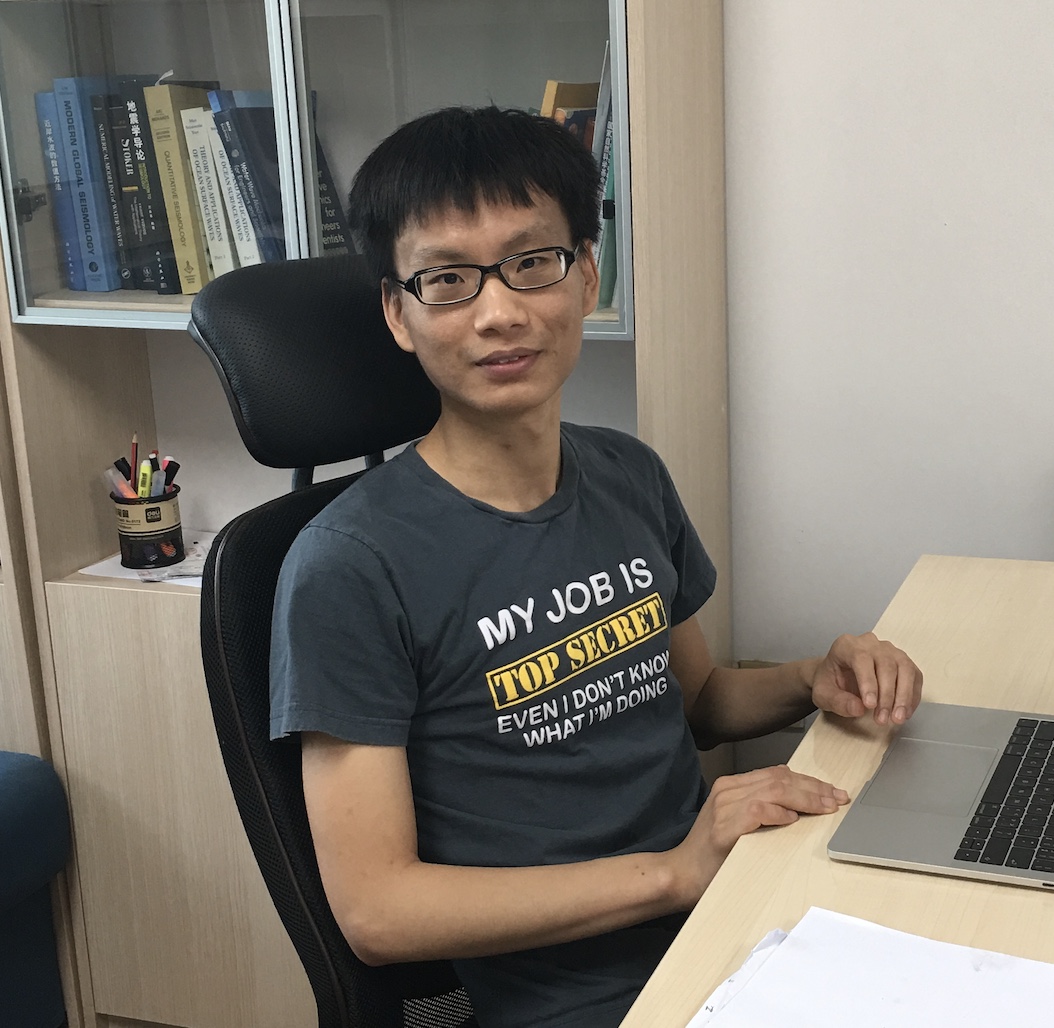


工程力学系
电子邮件:anchao@sjtu.edu.cn
通讯地址:上海市东川路800号上海交通大学木兰船建大楼A802-2
工作经历:
2022.7 -- 上海交通大学船建学院 教授
2017.2 -- 上海交通大学船建学院 特别副研究员、助理教授、长聘教轨副教授
2015.9 -- 2017.1 加州大学洛杉矶分校地球物理系 博士后(导师:Lingsen Meng)
2015.2 -- 2015.8 康奈尔大学土木与环境工程学院 博士后(导师:Philip Liu)
教育经历:
2011.1 -- 2015.1 康奈尔大学土木与环境工程学院 博士(导师:Philip Liu)
2007.9 -- 2010.7 北京大学地球物理系 硕士(导师:蔡永恩)
2003.9 -- 2007.7 北京大学地球物理系 学士
我的研究方向是与流体有关的地震学现象,称之为流体地震学或地震流体力学。地球表面71%的面积被海洋所覆盖,在海洋中经常使用海底压强计、海底地震仪等仪器进行地震学观测,观测数据的成因机制常常涉及较多的流体力学过程,因此数据的理论解析及应用成为难点。研究目标是深刻理解观测数据中伴随的流体力学现象、准确解析数据中包含的地球科学学信息。具体的研究内容包括:海啸及海啸预警、海底压强数据、海底地震仪噪声。
① 海啸及海啸预警
* 俯冲带地震海啸的耦合生成过程,水内声波的观测及其在海啸预警方面的应用
* 海啸反演,海啸数据对地震破裂的约束
* 海啸灾害的概率性评估,考虑区域地质构造条件对海啸概率评估的影响
② 海底压强
* 海啸压强数据的成因机制及其理论解,海底压强计的仪器设计
* 海底压强数据的应用
③ 海底地震仪的噪声
* 海底地震仪受到海洋水波、海底洋流产生噪声的力学机制、降噪方法
* 海底地震仪噪声数据的应用,反推海底洋流信息
热烈欢迎力学、地球物理学背景的学生报考硕士、博士研究生,欢迎博士后联系合作,欢迎本科生加入PRP和大学生创新实践项目。研究小组目前的成员有:朱艺帆(博士生,zyftop@sjtu.edu.cn),宋林涧(博士生,washjd@sjtu.edu.cn),邓涵(博士生,winterborn@sjtu.edu.cn),张淳(硕士生,caydezc3182@sjtu.edu.cn),詹晓波(硕士生,zhanxiaobo@sjtu.edu.cn)。
2023.1 -- JGR:Solid Earth 副主编
2020.11 -- International Journal of Ocean and Coastal Engineering 执行编委
2020.1 -- 上海佘山地球物理国家野外科学观测研究站海洋地震研究室副主任
一作及通讯作者期刊论文:
2022
[20] Deng H., An C.*, Cai C., Ren H., Theoretical Solution and Applications of Ocean Bottom Pressure Induced by Seismic Waves at High Frequencies, GRL (2022).
[19] An C.*, Cai C., Zhou L., Yang T., Characteristics of low-frequency horizontal noise of ocean-bottom seismic data, SRL (2022).
2021
[18] 管加深,安超*,刘桦,考虑区域地质构造特征的概率性海啸灾害评估,水动力学研究与进展A辑(2021).
[17] Zhu Y., An C.*, Wang T., Liu H., Time-Dependent Tsunami Source Following the 2018 Anak Krakatau Volcano Eruption Inferred from Nearby Tsunami Recordings, China Ocean Engineering (2021).
[16] 安超, 海啸和海啸预警的研究进展与展望, 中国科学:地球科学(2021).
2020
[15] Guan J., An C.*, Tsunami Hazard Assessment along Chinese Coast using Scaling Relations Developed for Tsunami Prediction, IJOCE (2020).
[14] Hu C., An C.*, Liu H., A numerical study of tsunami generation by horizontal displacement of sloping seafloor, Journal of Earthquake and Tsunnami (2020).
[13] An C.*, Wei S., Cai C., Yue H., Frequency Limit for the Pressure Compliance Correction of Ocean‐Bottom Seismic Data, SRL (2020).
[12] Li Z., An C.*, Liu H., Evaluation of different earthquake scaling relations on the generation of tsunamis and hazard assessment, Ocean Engineering (2020).
2018
[11] An C.*, Liu H., Ren Z. and Yuan Y., Prediction of tsunami waves by uniform slip models, JGR:Oceans (2018).
[10] An C.*, Liu P. and Meng L., A sensitivity analysis of tsunami inversions on the number of stations, GJI (2018).
2017
[9] An C.*, Cai C., Zheng Y., Meng L. and Liu P., Theoretical solution and applications of ocean-bottom pressure induced by seismic seafloor motion, GRL (2017).
[8] An C., Yue H., Sun J.*, Meng L. and Baez J.C., The 2015 Illapel Chile (Mw=8.3) earthquake: direction-reversed along-dip rupture with localized water reverberation, BSSA (2017)
[7] An C. and Meng L.*, Time reversal imaging of the 2015 Illapel tsunami source, GRL (2017)
2016
[6] An C.* and Liu P., Analytical solutions for estimating tsunami propagation speeds, Coastal Engineering (2016)
[5] An C. and Meng L.*, Application of array backprojection to tsunami prediction and early warning, GRL (2016)
2015
An C., INVERSION OF TSUNAMI WAVEFORMS AND TSUNAMI WARNING. PhD thesis, Cornell University, 2015 January.
2014
[4] An C., Sepulveda I. and Liu P.*, Tsunami source and its validation of the 2014 Iquique, Chile, earthquake, GRL (2014)
[3] An C. and Liu P., Characteristics of leading tsunami waves generated in three recent tsunami events, Journal of Earthquake and Tsunami(2014)
2012
[2] An C., Liu P.* and Seo S.N., Large-scale edge waves generated by a moving atmospheric pressure, Theoretical and Applied Mechanics Letters (2012).
2010
[1] An C. and Cai Y.*, The effect of beach slope on the tsunami run-up induced by thrust fault earthquakes, Procedia Computer Science (2010).
秋季:《理论力学》 本科生(机动学院英文授课)
春季:《水波动力学》 研究生(英文授课)
2018 上海市浦江人才
2021 自然科学基金委优秀青年基金(交叉科学部)
(1) Tsunami Downloader
These Python scripts download and display tsunami data from NOAA and IOC. It will be convenient to check if tsunamis are generated after an earthquake.
![]() TsunamiDataDownload-v2.0-manual.pdf (5.7 M)
TsunamiDataDownload-v2.0-manual.pdf (5.7 M)
![]() TsunamiDataDownload-v2.0.zip (1.5 M)
TsunamiDataDownload-v2.0.zip (1.5 M)
(2) pcomcot
pcomcot solves linear and nonlinear shallow water wave equatios to simulate the generation, propagation and runup of tsunami waves. It is parallelized using MPI, and can use multiple nested grids. The algorithm and codes are developed based on the COrnell Multigrid COupled Tsunami package (COMOCT). This released version is tested against a few benchmarks, and it is stable, although the user manual needs further improvements.
![]() User Manual For PCOMCOT.pdf (0.9 M)
User Manual For PCOMCOT.pdf (0.9 M)
![]() PCOMCOT1.0.zip (42 K)
PCOMCOT1.0.zip (42 K)
![]() example_2011Tohoku.zip (33 M)
example_2011Tohoku.zip (33 M)